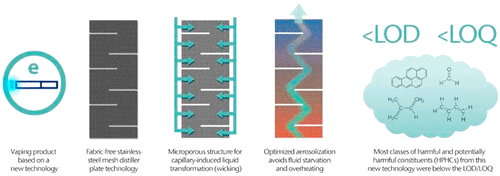当前位置:
X-MOL 学术
›
Chem. Res. Toxicol.
›
论文详情
Our official English website, www.x-mol.net, welcomes your feedback! (Note: you will need to create a separate account there.)
Comprehensive Chemical Characterization of the Aerosol Emissions of a Vaping Product Based on a New Technology.
Chemical Research in Toxicology ( IF 4.1 ) Pub Date : 2020-03-03 , DOI: 10.1021/acs.chemrestox.9b00442 James Nicol 1 , Rory Fraser 2 , Liam Walker 2 , Chuan Liu 2 , James Murphy 2 , Christopher John Proctor 2
Chemical Research in Toxicology ( IF 4.1 ) Pub Date : 2020-03-03 , DOI: 10.1021/acs.chemrestox.9b00442 James Nicol 1 , Rory Fraser 2 , Liam Walker 2 , Chuan Liu 2 , James Murphy 2 , Christopher John Proctor 2
Affiliation

|
Around 10 million people in the United States and 3 million people in the United Kingdom are estimated to use vaping category products. There are some estimates that there will be 75-80 million vapers worldwide by 2020. Most of these products are based on coil-and-wick technology. Because the heating and aerosol formation are separate processes, the system can lead to dry-wicking and elevated emission of carbonyls if designed and/or manufactured poorly. Low-nicotine and low-power coil-and-wick devices have also been linked to increased exposure to formaldehyde due to compensatory behavior by users. We characterized the emissions of a vaping product which uses a fabric-free stainless-steel mesh distiller plate technology that heats and aerosolizes the e-liquid in a single process. The plate has a microporous structure for capillary-induced liquid transformation (wicking) and aerosolization that is optimized to avoid fluid starvation and overheating and improved control. Compared with emissions previously reported for a coil-and-wick nicotine vaping product (e-cigarette), most classes of harmful and potentially harmful constituents (HPHCs) from this vaping product were below the level of detection or quantification. For those that were quantifiable, this vaping product generally had lower levels of emissions than the e-cigarette, including carbonyls. Formaldehyde and methyl glyoxal levels did not differ significantly between vaping products. In this system, the single mode of liquid transfer and vapor formation permits high aerosol mass delivery but further reduces emissions of HPHCs that may be present in conventional e-cigarette aerosol, by lessening the risk of thermal breakdown of the aerosol-generating solvent mixture.
中文翻译:

基于新技术的雾化产品气溶胶排放物的综合化学表征。
据估计,美国约有1000万人和英国有300万人使用vaping类产品。据估计,到2020年,全球将有75-80百万个电子烟。这些产品大多数基于线圈和灯芯技术。因为加热和气雾形成是分开的过程,所以如果设计和/或制造不当,则该系统会导致干芯吸和羰基化合物的排放增加。由于使用者的补偿行为,低烟碱和低功率线圈芯装置也与甲醛暴露增加有关。我们表征了使用无织物不锈钢网状蒸馏板技术的雾化产品的排放量,该技术可在单个过程中加热和雾化电子液体。该板具有微孔结构,可进行毛细管诱导的液体转化(芯吸)和雾化,该结构经过优化,可避免流体不足和过热,并改善了控制。与先前报道的卷烟芯尼古丁雾化产品(电子烟)的排放相比,该雾化产品中的大多数有害和潜在有害成分(HPHCs)类别都低于检测或定量水平。对于那些可量化的产品,这种雾化产品的排放水平通常低于电子烟,包括羰基化合物。蒸气产品之间的甲醛和甲基乙二醛含量没有显着差异。在这个系统中
更新日期:2020-03-03
中文翻译:

基于新技术的雾化产品气溶胶排放物的综合化学表征。
据估计,美国约有1000万人和英国有300万人使用vaping类产品。据估计,到2020年,全球将有75-80百万个电子烟。这些产品大多数基于线圈和灯芯技术。因为加热和气雾形成是分开的过程,所以如果设计和/或制造不当,则该系统会导致干芯吸和羰基化合物的排放增加。由于使用者的补偿行为,低烟碱和低功率线圈芯装置也与甲醛暴露增加有关。我们表征了使用无织物不锈钢网状蒸馏板技术的雾化产品的排放量,该技术可在单个过程中加热和雾化电子液体。该板具有微孔结构,可进行毛细管诱导的液体转化(芯吸)和雾化,该结构经过优化,可避免流体不足和过热,并改善了控制。与先前报道的卷烟芯尼古丁雾化产品(电子烟)的排放相比,该雾化产品中的大多数有害和潜在有害成分(HPHCs)类别都低于检测或定量水平。对于那些可量化的产品,这种雾化产品的排放水平通常低于电子烟,包括羰基化合物。蒸气产品之间的甲醛和甲基乙二醛含量没有显着差异。在这个系统中


























 京公网安备 11010802027423号
京公网安备 11010802027423号